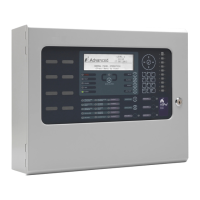5.4 Appendix 4 – Cause and Effect Programming Example
5.4.1 Introduction
By default, all sounders and output devices will turn on immediately as soon as a fire is detected anywhere in
the system. For example:
Quite often an installation will require a more complex “Cause and Effect” solution. Consider a multiple story
building where phased evacuation is required when a fire occurs on a particular floor. For example:
Any Fire on Floor 7
(From Zones 22, 23 or 24)
DELAY for 30 seconds, then start
PULSING. After 2 minutes turn ON
DELAY for 30 seconds, then start
PULSING. After 2 minutes turn ON
5.4.2 Output Groups
There may be several sounders on each floor. These can be grouped together using the Output Groups so that
a single group number can easily reference all sounders on a particular floor in the panel. For example:
Assign All Sounders of Floor 6
Assign All Sounders of Floor 7
Assign All Sounders of Floor 8
Refer to Section 3.3.2.8 for how to assign the output group to a loop output device. Refer to Section 3.3.20.1 for
how to assign the output group to an internal panel circuit.
5.4.3 Styles
In the example, there are two ways in which the sounders should ring. These two operational characteristics can
be defined as Styles in the panel. For example:
The first Style is that the sounders should turn on immediately a fire is recognised in Zone 22 or in Zone 23 or in
Zone 24. The panel contains a default Style (Style 00) for this method of operation.
The second Style is that the sounders should stay silent for 30 seconds and then start pulsing. After 2 minutes
of pulsing, they should then turn on. This is a little more complex but is easy to program. In the following
description, a new Style (Style 2) will be defined for this purpose.
It is quite likely that Style 2 will be used extensively in the cause and effect programming for the rest of the
building. For example, a fire on Floor 8 may also require the sounders on Floors 7 and 8 to operate in this
manner.
www.acornfiresecurity.com
www.acornfiresecurity.com

